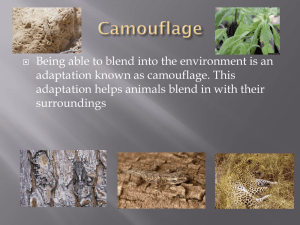File
advertisement
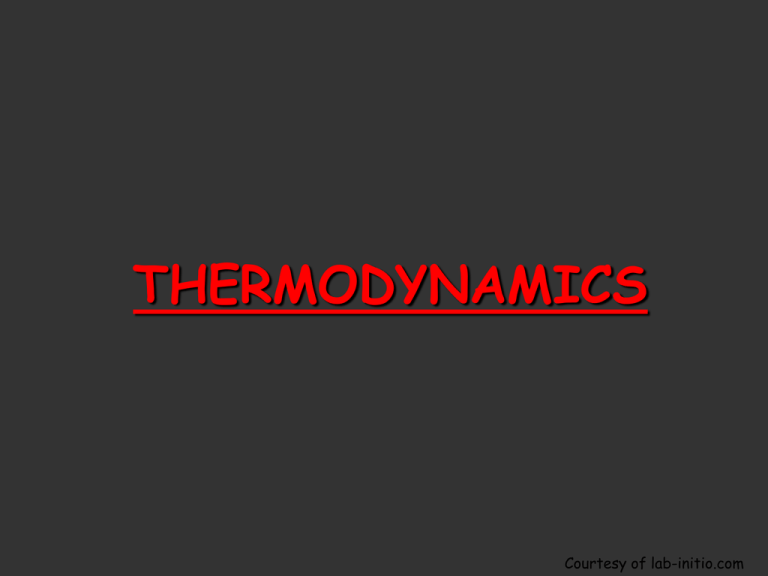
THERMODYNAMICS Courtesy of lab-initio.com Units for Measuring Heat The Joule is the SI system unit for measuring 2 heat: 1 kg m 1 Joule 1 newton meter 2 s The calorie is the heat required to raise the temperature of 1 gram of water by 1 Celsius degree 1 calorie 4 . 18 Joules 1 L atm = 101.3 J Definitions #1 Energy: The capacity to do work or produce heat Potential Energy: Energy due to position or composition Kinetic Energy: Energy due to the motion of the object KE 1 2 mv 2 Definitions #2 Law of Conservation of Energy: Energy can neither be created nor destroyed, but can be converted between forms The First Law of Thermodynamics: The total energy content of the universe is constant State Functions depend ONLY on the present state of the system ENERGY IS A STATE FUNCTION A person standing at the top of Mt. Everest has the same potential energy whether they got there by hiking up, or by falling down from a plane WORK IS NOT A STATE FUNCTION WHY NOT??? E = q + w E = change in internal energy of a system q = heat flowing into or out of the system -q if energy is leaving to the surroundings +q if energy is entering from the surroundings w = work done by, or on, the system -w if work is done by the system on the surroundings +w if work is done on the system by the surroundings Energy Change in Chemical Processes Endothermic: Reactions in which energy flows into the system as the reaction proceeds. + qsystem - qsurroundings Energy Change in Chemical Processes Exothermic: Reactions in which energy flows out of the system as the reaction proceeds. - qsystem + qsurroundings Work, Pressure, and Volume w PV Expansion +V (increase) -w results Esystem decreases Work has been done by the system on the surroundings Compression -V (decrease) +w results Esystem increases Work has been done on the system by the surroundings Enthalpy • H is a state function – ΔH doesn’t depend on the pathway between the two states H = E + PV, E is internal energy of the system, P is pressure of the system, and V is volume of the system. At constant pressure and knowing only P-V work is allowed (w=-PΔV), we can derive: -ΔH = q, at constant pressure ΔH = Hρroducts - Hreactants Example 6.4 • When 1 mole of methane is burned at constant pressure, 890 kJ of energy is released as heat. Calculate ∆H for a process in which a 5.8 g sample of methane is burned at constant pressure. Given: Find: ∆H of the rxn (KJ) • Mass = 5.8 g CH₄ • Molar mass CH₄ = 16.04 g • q of the product = ΔH = -890 kJ/mol CH₄ Find moles of methane: 5.8 g 1 mole = 0.36 mol 16.04g ∆H = .36 mol -890 kJ = -320 kJ, exothermic 1 mol Calorimetry The amount of heat absorbed or released during a physical or chemical change can be measured, usually by the change in temperature of a known quantity of water in a calorimeter. Specific Heat The amount of heat required to raise the temperature of one gram of substance by one degree Celsius. Substance Specific Heat (J/g·K) Water (liquid) 4.18 Ethanol (liquid) 2.44 Water (solid) 2.06 Water (vapor) 1.87 Aluminum (solid) 0.897 Carbon (graphite,solid) 0.709 Iron (solid) 0.449 Copper (solid) 0.385 Mercury (liquid) 0.140 Lead (solid) 0.129 Gold (solid) 0.129 Catalyst (10 mins) In book: P.277 #49 Calculations Involving Specific Heat at constant pressure q s m T q = Heat lost or gained s = Specific Heat Capacity T = Temperature change Assumption: that the density of the solution is the same as pure water, 1 g/mL. Otherwise, a different density will be given. Example 1 • 1.00 x 10² mL of 0.500 M HCl was mixed with 100. mL of 0.500 M NaOH in a constant pressure calorimeter. Initially, both solutions are at 22.5˚C. Find the heat change on a molar basis for the rxn. NaOH(aq) + HCl(aq) -> NaCl(aq) + H₂O (l) • Qcal (surrounding): qrxn (∆H)(system): 100. mL HCl soln = 100g .05 mols HCl 100 mL NaOH soln = 100 g .05 mols NaOH s = 4.18 J/g C Ti: 22.50 ˚C Tf: 25.86˚C Example 2 • A 3.53 g sample of ammonium nitrate (NH₄NO₃) was added to 80.0 mL of water in a coffee cup calorimeter. The water temp decreased from 21.6 C to 18.1 C. Find the ∆Hrxn for: 2NH₄NO₃(s) -> 2NH₄⁺(aq) + 2NO₃⁻(aq) Qcal (surroundings) ∆Hrxn (system) 3.53 g NH₄NO₃ 3.52 g NH₄NO₃ 80.0 mL water = 80.0g Total mass=83.5g S= 4.18 J/g C Ti= 21.6 ˚C Tf= 18.1 ˚C Classwork • Do #54, then 53, which will be a little different • Review sec 6.2 in packet, then work on 39, 41, 43, 49, 51, 57. • Recommended reading: Calorimetry p.244-248, then 248-251
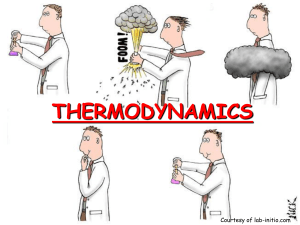
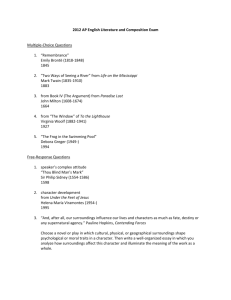
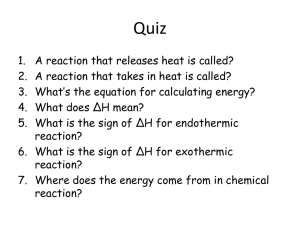
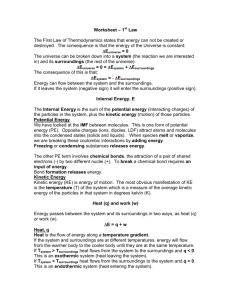


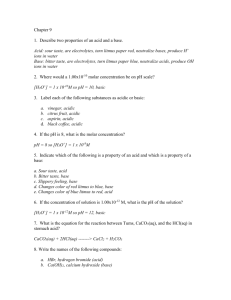
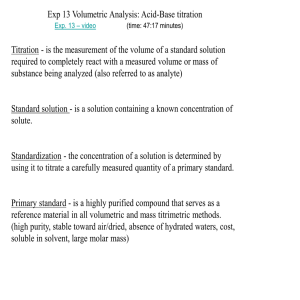
![calorimeter heat of neutralization YUMI[1]](http://s3.studylib.net/store/data/009052957_1-39664c4fe77e79ee41660453fa3dc5cb-300x300.png)


